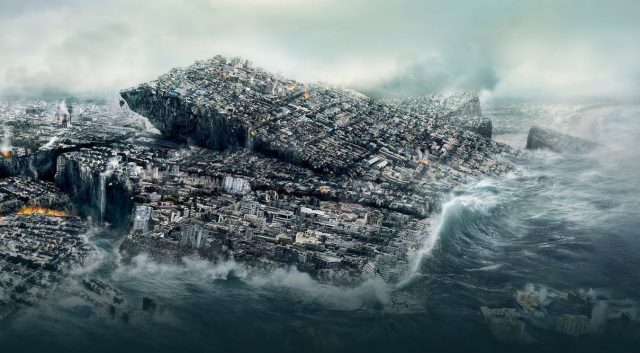A few years ago, I watched a movie called 2012 which portrayed the end of the world according to the Mayan calendar.
The movie began with the world leaders coming together and putting away their most valuable possessions. For example, the famous painting of the Mona Lisa was replaced with a fake one while the original one was supposed to be locked away in a vault in Switzerland.
One might wonder if people are truly dumb to differentiate between real and fake. However, the movie gave the assurance that unless laser technology was used, no one would ever know.

To conclude, the movie is a piece of fiction however not totally far from the truth. The way global warming has been acting up and the rapid proliferation in pollution just might be the beginning of the end.
One particular fact that is indeed true in the movie and has been inspired by a real-life example is that the Earth does possess a vault that can store precious data for over 500 years.
Repository For The Memory Of The World
Set inside an Arctic mountain in a decommissioned coal mine on the Svalbard archipelago, Norway, the Arctic World Archive also known as AWA holds a collection of valuable digital artifacts and unique information from over 15 nations.
This archive is built close to the Global or Svalbard Seed Vault which is a secure backup facility for the world’s crop diversity on the Norwegian island.
Established in 2017, this repository vault is run as a profit-making business by a private company called Piql which aims to help preserve the digital memory of the world, including art, literature, and lines of code, for more than 500 years.
However, according to the visitors of the vault, this repository is not just for storing data but is also an underground bunker in case of a global catastrophe. Not only does the vault protect data and store them but also protects the world’s agricultural genetic diversity and the food of our future, in case the world, as we know it, ends.
What The Arctic World Archive Looks Like
Known as one of the most geopolitically secure places in the world, the facility is a large steel vault located somewhere between 490 ft and 980 ft below the ground or permafrost inside an abandoned coal mine called Store Norske Gruve 3.
The coal mine reaches over 980 ft into the side of a mountain. The vault is secured with a concrete wall and a steel gate. The deposits themselves are stored in secure shipping containers behind the gate.
The reason behind keeping the collection of data offline is to fend off cyberattacks, and the cold conditions of Svalbard help in long-term storage. It is the ideal climate.
Read More: An Underwater Village In Goa That Emerges From The Water Just Once A Year
The Data That Has Been Stored Till Now
Film reels have been used to store the data. These film reels have been made using a refined version of ordinary darkroom photography technology. The film is made of polyester coated in silver halide crystals and powder-coated with iron oxide, and has a lifespan of at least 500 and possibly up to 2000 years if stored in optimum conditions.
The National Archives of Mexico and Brazil were the first to make their deposits followed by other organizations such as the Vatican Library, the National Museum of Norway, the ESA, and major global corporations.
According to Erik Cardoso, National Archive of Mexico,
“It is an amazing feeling to know that my own nation’s memory will be kept safe for future generations to see on this Arctic island.”
Now people in the future may not be able to decode the past. Thereby, keeping that in mind a similar type of Rosetta Stone has been devised to help decode the data, in the form of a guide to interpreting the Archive.
Brazil and Norway have archived their constitutions and other important historical papers.
The archive includes information about the biodiversity of Australia, and examples of culturally significant Australian works. It includes the Atlas of Living Australia and machine learning models created by Geoscience Australia, which assist in understanding topics such as bushfires and climate change.
The archive also stores a digitized version of the famous painting The Scream by Edvard Munch for the National Museum of Norway, and a digitized version of Dante’s master-work of Italian literature, The Divine Comedy, for the Vatican Library.
Apart from these, the Archive is in possession of high-resolution images of the Ajanta Caves and Bhagavad Gita.
As one can see, this Archive is no less than a hidden treasure—a treasure filled with data, culture, art, and literature.
Disclaimer: This post is fact-checked.
Image Sources: Google Images
Sources: Euronews, Arctic World Archive, The Guardian
Find the Blogger: @Rishita51265603
This post is tagged under the arctic vault, doomsday vault, Svalbard vault, vault that stores data, data worth more than 500 years, Arctic mountain, Norwegia, repository vault, Piql, Github, geopolitically secure place, underground bunker, agricultural genetic diversity, ideal climate, offline data storage, Vatical library, National Archives of Mexico and Brazil, Bhagavad Gita, Ajanta caves, The Scream by Edvard Munch, The Divine Comedy, Dante, The Scream by Edvard Munch, Rosetta Stone
We do not hold any right, copyright over any of the images used, these have been taken from Google. In case of credits or removal, the owner may kindly mail us.
More Recommendations:
Padmanabhaswamy Temple ‘Vault B’ In Kerala: The Only “Cursed” Inaccessible Chamber In The Entire World